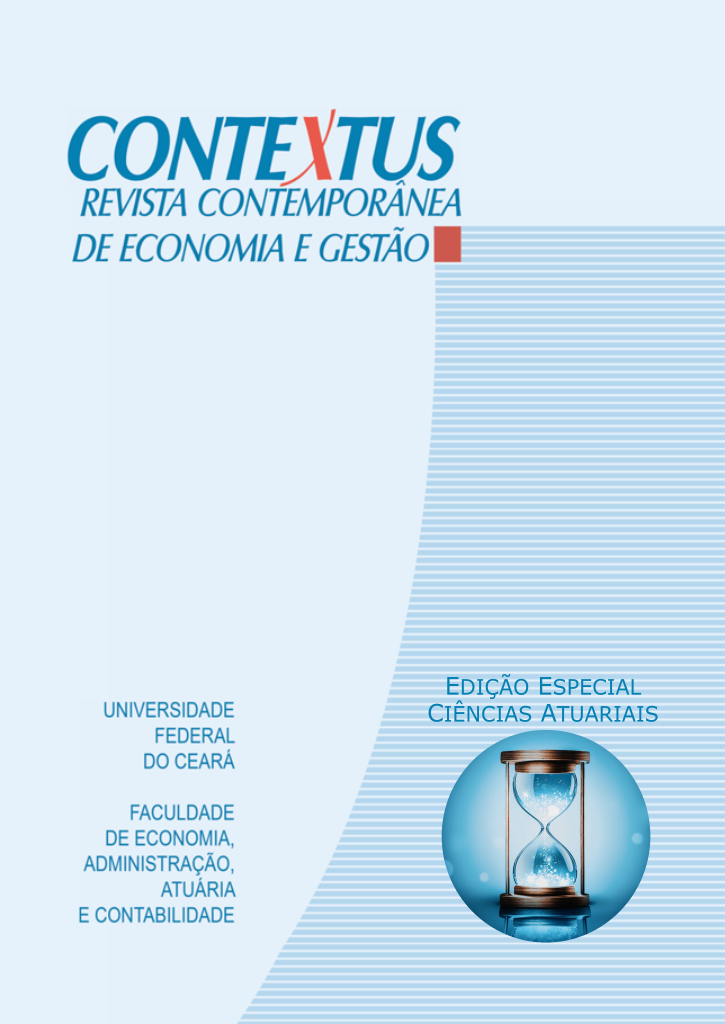El modelo de regresión simplex como metodología de análisis actuarial
DOI:
https://doi.org/10.19094/contextus.2023.83379Palabras clave:
regresión, simplex, metodologia, actuarial, análisisResumen
El mercado de la gestión de riesgos evoluciona rápidamente, por lo que los analistas actuariales se enfrentan a la necesidad de nuevas metodologías de análisis. Sin embargo, el uso de metodologías incorrectas para la modelización actuarial puede perjudicar seriamente la toma de decisiones estratégicas. Este estudio pretende introducir el modelo de regresión simplex como metodología adecuada para la modelización actuarial de datos cuyos valores pertenecen al intervalo unitario. Haciendo uso de un conjunto de datos sobre gestión de riesgos, se compararon el modelo lineal con distribución normal y el modelo de regresión propuesto. La evaluación de los modelos presentados concluyó por la calidad de la modelización a través de la regresión simplex.
Citas
Arkes, J. (2020). Teaching Graduate (and Undergraduate) Econometrics: Some Sensible Shifts to Improve Efficiency, Effectiveness, and Usefulness. Econometrics, 8(3), 1-36. http://doi.org/10.2139/ssrn.3427791
Atkinson, A. C. (1981). Two graphical display for outlying and influential observations in regression. Biometrika, 68, 13-20. https://doi.org/10.1093/biomet/68.1.13
Dawes, J., Kennedy, R., Green, K., & Sharp, B. (2018). Forecasting advertising and media effects on sales: Econometrics and alternatives. International Journal of Market Research, 60(6), 611-620. https://doi.org/10.1177/1470785318782871
Eling, M., & Wirfs, J. (2019). What are the actual costs of cyber risk events?. European Journal of Operational Research, 272(3), 1109-1119. https://doi.org/10.1016/j.ejor.2018.07.021
Emirza, S., & Katrinli, A. (2019). The relationship between leader construal level and leader-member exchange relationship: The role of relational demography. Leadership & Organization Development Journal, 40(8), 845-859. https://doi.org/10.1108/LODJ-02-2019-0084
Erdemir, Ö. K., & Karadağ, Ö. (2020). On comparison of models for count data with excessive zeros in non-life insurance. Sigma Journal of Engineering and Natural Sciences, 38(3), 1543-1553.
Espinheira, p. L., & Oliveira, A. (2020). Residual and influence analysis to a general class of simplex regression. TEST, 29, 523–552. https://doi.org/10.1007/s11749-019-00665-3
Espinheira, P. L., Silva, L.C.M., & Cribari-Neto, F. (2021). Bias and variance residuals for machine learning nonlinear simplex regressions. Expert Systems With Applications, 185, 1-13. https://doi.org/10.1016/j.eswa.2021.115656
Ferrarri, S. L. P., & Cribari-Neto, F. (2004). Beta regression for modelling rates and proportions. Journal of Applied Statistics, 31, 799-815. https://doi.org/10.1080/0266476042000214501
Frees, E.W. (2012). Regression Modeling with Actuarial and Financial Applications (1 ed.). Cambridge: Cambridge University Press.
Guillen, M., Bermúdez, L., & Pitarque, A. (2021). Joint generalized quantile and conditional tail expectation regression for insurance risk analysis. Mathematics and Economics, 99, 1-8. https://doi.org/10.1016/j.insmatheco.2021.03.006
Greberg, F., & Rylander, A. (2022). Using Gradient Boosting to Identify Pricing Errors in GLM-Based Tariffs for Non-life Insurance. Stockholm, Sweden.
Hirt, E. R., & Guevara, H. R. (2019). Forecasting and prediction. In Handbook of research methods in consumer psychology, 241-258, Routledge.
Kieschinick, R., & Mccullough, B. D. (2003). Regression analysis of variates observed on (0,1): percentages, proportions and fractions. Statistical Modelling, 3(3), 193-213. https://doi.org/10.1191/1471082X03st053oa
Lee, G., Manski, S., & Maiti, T. (2020). Actuarial applications of word embedding models. ASTIN Bulletin: The Journal of the IAA, 50(1), 1-24. https://doi.org/10.1017/asb.2019.28
Liu P., Yuen K.C., Wu L.C., Tian G.L., & Li T. (2020). Zero-one-inflated simplex regression models for the analysis of continuous proportion data. Statistics and Its Interface. 2020; 13(2), 193-208. https://doi.org/10.4310/SII.2020.v13.n2.a5
López, F. O. (2013). A Bayesian Approach to Parameter Estimation in Simplex Regression Model: A compararison with Beta Regression. Revista Colombiana de Estadística, 36, 1-21. http://www.scielo.org.co/scielo.php?script=sci_arttext&pid=S0120-17512013000100001&lng=en&tlng=en
Mccullagh, P., & Nelder, J. A. (1989). Generalized Linear Models (02 ed.). London: Chapman and Hall.
Meireles, L. C. (2015). Coeficientes de Predição para os Modelos de Regressão Beta e Simplex (Master’s dissetation). Federal University of Pernambuco, Recife, PE, Brazil.
Miyashiro, E. S. (2008). Modelos de regressão beta e simplex para análise de proporções (Doctoral thesis). University of São Paulo, São Paulo, SP, Brazil.
Nagelkerke, N. J. D. (1991). A note on a general definition of the coefficient of determination. Biometrika, 78(3), 691-692. https://doi.org/10.1093/biomet/78.3.691
Nelder, J. A., & Wedderburn, R. W. M. (1972). Generalized linear models. Journal of the Royal Statistical Society, 135, 370-384. https://doi.org/10.2307/2344614
Oliveira, A. (2015). Regressão Simplex Não Linear: Inferência e Diagnóstico (Master’s dissetation). Federal University of Pernambuco, Recife, PE, Brazil.
Oliveira, A., Silva, J., & Espinheira, P. L. (2022). Bootstrap-based inferential improvements to the simplex nonlinear regression model. PLOS ONE, 17, 1-27. https://doi.org/10.1371/journal.pone.0272512
Omari, C. O., Nyambura, S. G., & Mwangi, J. M. W. (2018). Modeling the frequency and severity of auto insurance claims using statistical distributions. Journal of Mathematical Finance, 8, 137-160. https://doi.org/10.4236/jmf.2018.81012
Radaelli, C.M., & Wagemann, C. (2019). What did I leave out? Omitted variables in regression and qualitative comparative analysis. Eur Polit Sci, 18, 275-290. https://doi.org/10.1057/s41304-017-0142-7
Rokicki, B., & Ostaszewski, K. (2022) Actuarial Credibility Approach in Adjusting Initial Cost Estimates of Transport Infrastructure Projects. Sustainability 2022, 14. https://doi.org/10.3390/su142013371
Santos, L. A. (2011). Modelos de Regressão Simplex: Resíduos de Pearson Corrigidos e Aplicações (Doctoral thesis). University of São Paulo, São Paulo, SP, Brazil.
Schmit, J.T., & Roth, K. (1990). Cost effectiveness of risk managements practice. The Journal of Risk and Insurance, 57(3), 455-470. https://doi.org/10.2307/252842
Song, P. X. -K., & Tan, M. (2000). Marginal models for longitudinal continuous proportional data. Biometrics, 56, 496-502. https://doi.org/10.1111/j.0006-341X.2000.00496.x
Song, P. X. -K., Qiu, Z., & Tan, M. (2004). Modelling heterogeneous dispersion in marginal models for longitudinal proportional data. Biometrical Journal, 46, 540-553. https://doi.org/10.1002/bimj.200110052
Sutejo, B.S.,Pranata, Y.K.N., & Mahadwartha, P.A. (2018). Demography factors, financial risk tolerance, and retail investors. Atlantis Press.
Venezuela, M. K. (2007). Equação de estimação generalizada e influência local para modelos de regressão beta com medidas repetidas (Doctoral thesis). University of São Paulo, São Paulo, SP, Brazil.
Wulff, J.N., & Villadsen, A.R. (2020). Keeping it within bounds: Regression analysis of proportions in international business. J Int Bus Stud, 51, 244-262. https://doi.org/10.1057/s41267-019-00278-w
Wu, X., Nethery, R.C., Sabath, M.B., Braun, D., & Dominici, F. (2020). Air pollution and COVID-19 mortality in the United States: Strengths and limitations of an ecological regression analysis. Science Advances, 6(45). https://doi.org/10.1126/sciadv.abd4049
Xie, S., & Lawniczak, A. (2018). Estimating Major Risk Factor Relativities in Rate Filings Using Generalized Linear Models. International Journal of Financial Studies, 6(4), 84. https://doi.org/10.3390/ijfs6040084
Xie, S., & Luo, R. (2022). Measuring Variable Importance in Generalized Linear Models for Modeling Size of Loss Distributions. Mathematics, 10(10), 16-30. https://doi.org/10.3390/math10101630
Yan X., Su X., & World Scientific (Firm). (2009). Linear regression analysis: theory and computing (1 ed.). Singapore: World Scientific Pub.
Publicado
Cómo citar
Número
Sección
Licencia
Derechos de autor 2023 Journal: only for the 1st publication

Esta obra está bajo una licencia internacional Creative Commons Atribución-NoComercial 4.0.
Os autores, no ato da submissão, aceitam a declaração abaixo:
Nós autores mantemos sobre nosso artigo publicado os direitos autorais e concedemos à revista Contextus o direito de primeira publicação, com uma licença Creative Commons na modalidade Atribuição – Não Comercial 4.0 Internacional, a qual permite o compartilhamento com reconhecimento da autoria e da publicação inicial nesta revista.
Temos ciência de estarmos autorizados a assumir contratos adicionais separadamente, para distribuição não exclusiva da versão do trabalho publicada nesta revista (ex.: publicar em repositório institucional ou como capítulo de livro), também com reconhecimento tanto da autoria, quanto da publicação inicial neste periódico.
Atestamos que o artigo é original ou inédito, não foi publicado, até esta data, em nenhum periódico brasileiro ou estrangeiro, quer em português, quer em versão em outra língua, nem está encaminhado para publicação simultânea em outras revistas.
Sabemos que o plágio não é tolerado pela revista Contextus e asseguramos que o artigo apresenta as fontes de trechos de obras citadas, incluindo os de qualquer trabalho prévio produzido e publicado pelos próprios autores.









3.png)


1.jpg)



1.jpg)


1.jpg)






.jpg)



1.jpg)

1.jpg)


1.jpg)

1.jpg)
1.jpg)
2.png)




1.jpg)
2.jpg)

1.jpg)





1.jpg)


1.jpg)
1.jpg)
